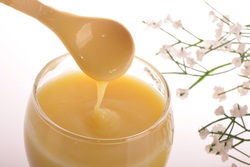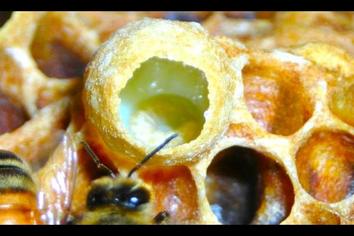Royal Jelly - Fountain of Youth

Royal jelly (or bee’s milk) is a white, milky substance that worker honey bees produce to feed the queen bee. All the larvae are fed with royal jelly only first three days of their lives. After that they are on diet consisting of honey, pollen and water. The queen bee on the other hand is fed royal jelly whole her life. To understand what is so special about the royal jelly and why it is called super food or fountain of youth let’s look into the development of the worker bees and the queen bee.
The Miracle of Royal Jelly
As we mentioned earlier, all the larvae are fed royal jelly for the first three days of their lives. They are fed diluted royal jelly with honey so liberally that they are actually lying in a pool of it. This feeding stops after three days and less rich food is provided to the larvae. During this final stages, the development of the sex glands of the bee are suppressed while the glands that secret royal jelly and the wax glands are developed. The worker bees will never try the royal jelly again.
The Miracle of Royal Jelly
As we mentioned earlier, all the larvae are fed royal jelly for the first three days of their lives. They are fed diluted royal jelly with honey so liberally that they are actually lying in a pool of it. This feeding stops after three days and less rich food is provided to the larvae. During this final stages, the development of the sex glands of the bee are suppressed while the glands that secret royal jelly and the wax glands are developed. The worker bees will never try the royal jelly again.

If the same larvae are fed royal jelly beyond the third day of their lives than a queen will be produced. Yes, you reading it right – the queen be is made from the same eggs as the worker bees and the only difference is their diet. The queen is supplied with the highly nutritious, hormone-rich royal jelly which single-handedly transforms are the regular larvae into a queen. As she is continued to be fed royal jelly past the first three days, the queen grows modified stinger. Her stinger is curved, not straight as the one of the worker bees and unlike them, the queen will not die after stinging. Another difference between the queen and the worker bee is that she does not have wax glands, no pollen baskets on her back legs and no hypopharyngeal glands to secrete royal jelly. The worker bee is the one that will build a comb, collect pollen and secrete royal jelly. The queen on the other hand will develop her sex organs and when she is fully developed (in 16 days) she will emerge noticeably larger.
Worker bee Queen bee
weight 125 mg 200 mg
length 12 mm 17 mm
Achieving adulthood 21 days 16 days
lifespan 7-8 weeks 5-7 years
As you see from the numbers above, the queen bee is not only larger, but her lifespan is 40 times longer than that of the worker bees. During that lifespan she will lay 2000 eggs each day. Each batch of eggs is two and half times greater in weight than her body. Here again comes the bee`s milk – the queen is fed only royal jelly through her whole life. This remarkable food alone ensures her superior development and incredible longevity. Don`t forget that she wasn’t born queen, she was made one.
Worker bee Queen bee
weight 125 mg 200 mg
length 12 mm 17 mm
Achieving adulthood 21 days 16 days
lifespan 7-8 weeks 5-7 years
As you see from the numbers above, the queen bee is not only larger, but her lifespan is 40 times longer than that of the worker bees. During that lifespan she will lay 2000 eggs each day. Each batch of eggs is two and half times greater in weight than her body. Here again comes the bee`s milk – the queen is fed only royal jelly through her whole life. This remarkable food alone ensures her superior development and incredible longevity. Don`t forget that she wasn’t born queen, she was made one.
So, what is in Royal Jelly?
Royal jelly is very complex. The analysis revealed that it contains:
67% water
12.5% protein
11% sugars
5.5% fatty acids
1% minerals
Literature points out that royal jelly contain around 2.8 % unidentifiable elements. And here, as with bee pollen, science still hasn’t been able to isolate and identify all the elements in the royal jelly, consequently not able to synthesize it in a lab.
Royal jelly is very rich in natural hormones and offers an abundance of vitamins B – including thiamine, riboflavin, pyridoxine, niacin, pantothenic acid, biotin, inositol and folic acid. It contains amino acids and acetylholine - important in the transmission of the nerve messages. Royal jelly is also rich in nucleic acids (DNA and RNA). It contains gelatine – precursor of collagen and powerful anti-aging element which keeps us youthful. Another important constituent present in royal jelly is gamma globulin – powerful infection-fighting and immuno-stimulating agent.
It also contains many trace minerals, some enzymes, antibacterial and antibiotic components, and trace amounts of vitamin C. scientists point out that if these antibacterial and antibiotic elements (such as decanoic acid) are missing from the royal jelly, it would be an excellent growing medium for all kind of harmful microbes. The fat-soluble vitamins, A, D, E and K, are completely absent from royal jelly.
Benefits of royal jelly
Royal jelly is praised for its rejuvenating and miracle healing properties. In the Orient, legends tell about people who regained powers and enjoyed long lives by daily intake of royal jelly. Today, there are scientific studies that indicate that these legends do have a realistic basis. The beneficial action of royal jelly is due to the presence and the synergy between various substances that are harmoniously bound to one another and mutually reinforcing their effects. Based on reports from the medical community, here are the possible benefits for us.
To summarize the benefits of this miracle natural product I will use a quote from Dr. Schmidt’s lecture “Royal Jelly in Diet, Prophylaxis and Therapy”:
“The authoritative sources now believe it is the interplay of all the complex factors present in royal jelly that works to preserve life and strength in the organism, that delays the aging process and helps the organism retain for as long as possible the physical freshness of the body, elasticity of the mind, and psychic buoyancy of the youth.”
You can usually find Royal Jelly in capsule or liquid form. The liquid form is placed into a honey base, which can be taken orally or mixed into beverages, meal-replacement shakes or smoothies. When purchasing Royal Jelly, you want to make sure that you only choose pure, high-quality jelly from a reputable source. Make sure there are no preservatives, additives or chemicals to the jelly.
It is extremely important to note that Royal Jelly should not be taken by everyone. As with anything, even natural products, there is a possibility for an individual to develop an allergic reaction. If you are allergic to bee stings, you should not take Royal Jelly, as side affects and reactions can include minor to severe skin irritations, difficulty breathing or even anaphylactic shock.
Royal jelly is very complex. The analysis revealed that it contains:
67% water
12.5% protein
11% sugars
5.5% fatty acids
1% minerals
Literature points out that royal jelly contain around 2.8 % unidentifiable elements. And here, as with bee pollen, science still hasn’t been able to isolate and identify all the elements in the royal jelly, consequently not able to synthesize it in a lab.
Royal jelly is very rich in natural hormones and offers an abundance of vitamins B – including thiamine, riboflavin, pyridoxine, niacin, pantothenic acid, biotin, inositol and folic acid. It contains amino acids and acetylholine - important in the transmission of the nerve messages. Royal jelly is also rich in nucleic acids (DNA and RNA). It contains gelatine – precursor of collagen and powerful anti-aging element which keeps us youthful. Another important constituent present in royal jelly is gamma globulin – powerful infection-fighting and immuno-stimulating agent.
It also contains many trace minerals, some enzymes, antibacterial and antibiotic components, and trace amounts of vitamin C. scientists point out that if these antibacterial and antibiotic elements (such as decanoic acid) are missing from the royal jelly, it would be an excellent growing medium for all kind of harmful microbes. The fat-soluble vitamins, A, D, E and K, are completely absent from royal jelly.
Benefits of royal jelly
Royal jelly is praised for its rejuvenating and miracle healing properties. In the Orient, legends tell about people who regained powers and enjoyed long lives by daily intake of royal jelly. Today, there are scientific studies that indicate that these legends do have a realistic basis. The beneficial action of royal jelly is due to the presence and the synergy between various substances that are harmoniously bound to one another and mutually reinforcing their effects. Based on reports from the medical community, here are the possible benefits for us.
- Fights infections and boosts immune system – Royal jelly contains gamma globulin - an important factor for fighting infections and stimulating immune system. Additionally, it contains decanoic acid – this is the build in antibiotic factor that helps control invasion of harmful bacteria and fungus.
- Rejuvenating effect – royal jelly stimulates the adrenal glands and increases metabolism, giving more energy, rapid recovery from fatigue and enhanced sexual capabilities.
- Cell regeneration – royal jelly inhibits the aging process, and helps maintain healthy skin tone and lustrous hair. As we age, we slowly lose ability to renew collagen. Royal jelly contains the precursor of collagen and gamma globulin, which delay or even reverse the aging process by increasing the activity of the protective mechanisms in the body and the revitalization of the cells. Also, royal jelly is effective in treating skin problems such as dry skin and acne.
- Corrects emotional problems – Scientists reported that royal jelly has a stimulating effect, mimicking that of the amphetamines without the side effects. Cases of anxiety, depression, shock, insomnia and senility all improve with royal jelly.
- Improves arterial health – Doctors pointed, that royal jelly helps atherosclerosis patients by correcting their high-blood serum cholesterol.
- Improves fertility and sexual health
To summarize the benefits of this miracle natural product I will use a quote from Dr. Schmidt’s lecture “Royal Jelly in Diet, Prophylaxis and Therapy”:
“The authoritative sources now believe it is the interplay of all the complex factors present in royal jelly that works to preserve life and strength in the organism, that delays the aging process and helps the organism retain for as long as possible the physical freshness of the body, elasticity of the mind, and psychic buoyancy of the youth.”
You can usually find Royal Jelly in capsule or liquid form. The liquid form is placed into a honey base, which can be taken orally or mixed into beverages, meal-replacement shakes or smoothies. When purchasing Royal Jelly, you want to make sure that you only choose pure, high-quality jelly from a reputable source. Make sure there are no preservatives, additives or chemicals to the jelly.
It is extremely important to note that Royal Jelly should not be taken by everyone. As with anything, even natural products, there is a possibility for an individual to develop an allergic reaction. If you are allergic to bee stings, you should not take Royal Jelly, as side affects and reactions can include minor to severe skin irritations, difficulty breathing or even anaphylactic shock.
